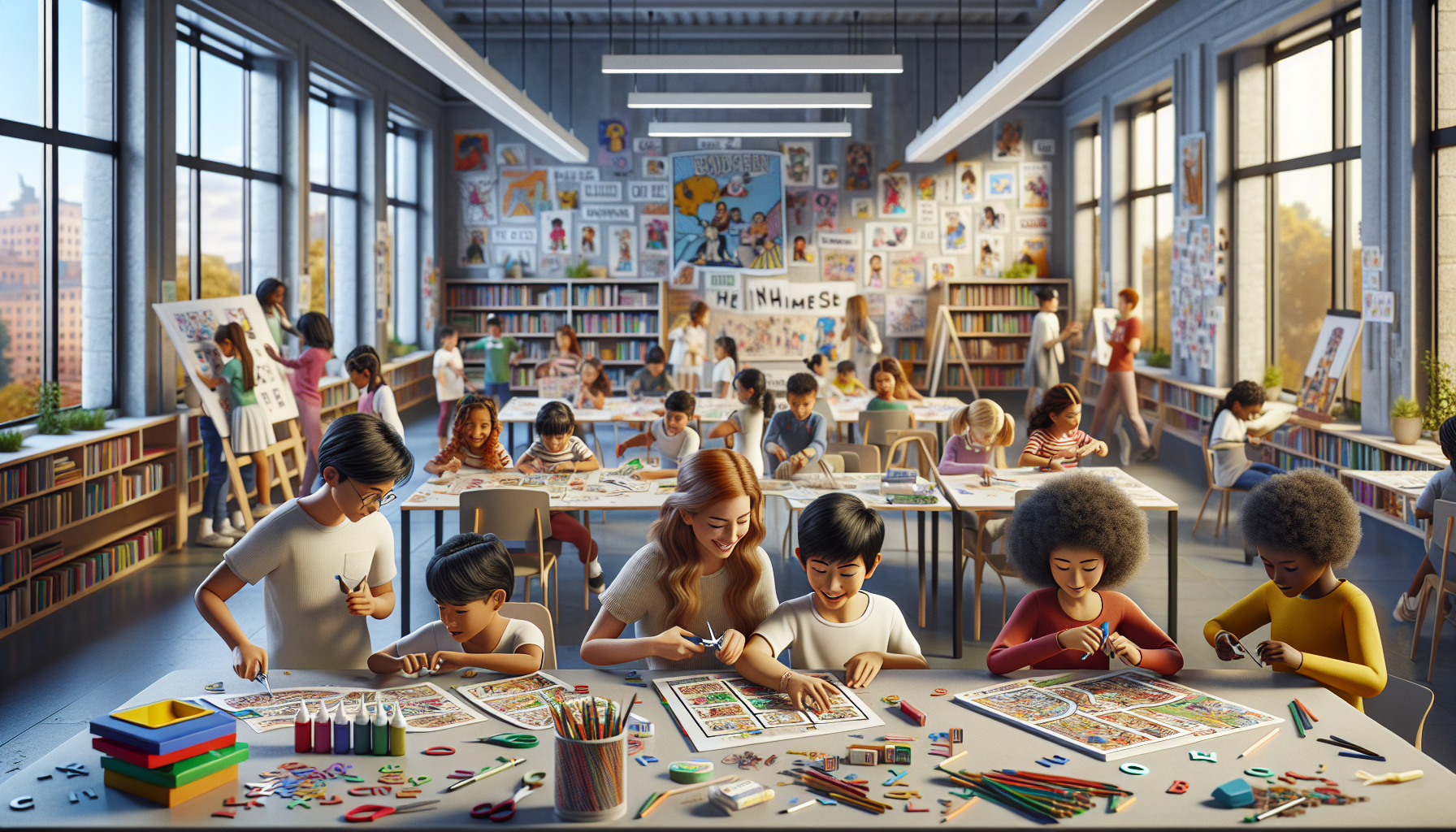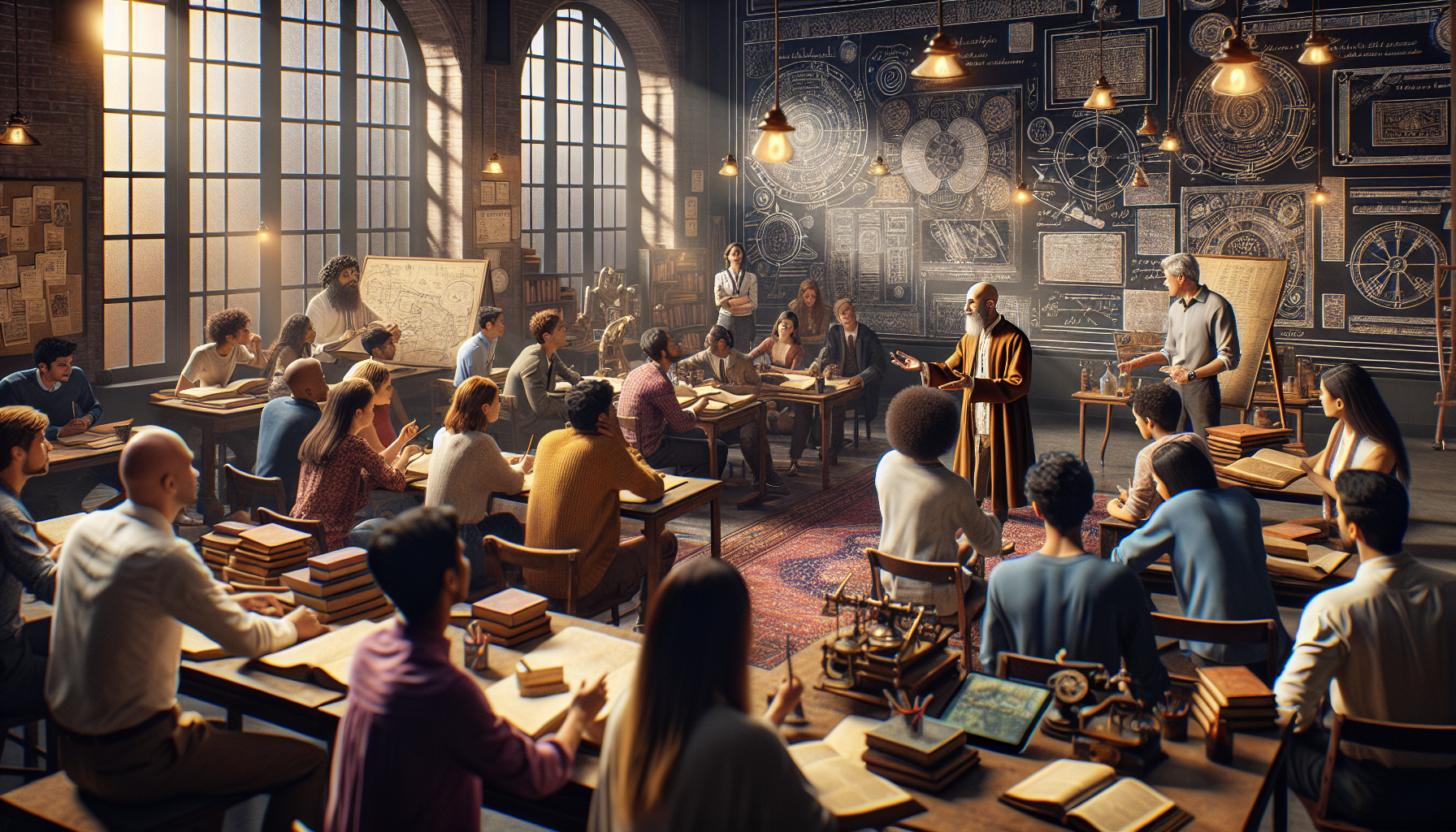In an age dominated by digital screens and rapid technological advances, the art of crafting—those tactile, hands-on activities that many of us fondly remember from our childhoods—may seem like a quaint relic of the past. However, it is precisely this hands-on approach that is experiencing a renaissance in educational circles, particularly when it comes to enhancing literacy skills. Welcome to a journey where scissors, glue, paper, and imagination converge to create a powerful toolkit for reading and writing success. This article delves into the magic that happens when creativity meets literacy, and why, in a world obsessed with virtual experiences, the simple act of crafting can hold the key to unlocking a child’s potential. 🎨
Imagine a classroom where the rustle of paper and the snip of scissors harmonize with the soft murmur of focused conversation. Here, crafting is not just an art class activity, but a dynamic, multi-sensory experience that lays the groundwork for literacy development. But why, you might ask, should we return to these seemingly simple activities in an era overflowing with educational apps and e-books? The answer lies in the tangible benefits that hands-on crafting offers: it engages multiple senses, fosters critical thinking, and, most importantly, makes learning an active, rather than passive, experience. Crafting, with its ability to bridge the gap between abstract concepts and concrete understanding, is a tool that educators and parents can no longer afford to overlook.
In this article, we will explore the myriad ways in which crafting can enhance literacy skills, beginning with its impact on fine motor development. The precision required in cutting, gluing, and assembling crafts translates into improved hand-eye coordination and dexterity—skills that are crucial when children begin to write. Furthermore, crafting activities often involve following instructions, sequencing, and problem-solving, all of which are foundational components of reading comprehension. Through crafting, children learn to process information in a structured manner, an ability that directly translates to improved literacy skills.
But the benefits of crafting extend beyond the mechanical aspects of reading and writing. Engaging in creative projects stimulates cognitive development and encourages imaginative thinking. When children are given the freedom to express themselves through art, they learn to generate ideas, make decisions, and communicate those ideas effectively—all skills that are vital for both reading and writing. Crafting also promotes a growth mindset; it teaches children that mistakes are not failures, but rather opportunities to learn and improve. This resilience and adaptability are key components of literacy success, as they encourage children to approach reading and writing with curiosity and confidence.
Finally, we will examine how crafting can foster a love for learning and literacy. The act of creating something tangible provides children with a sense of accomplishment and pride, which can boost their motivation and engagement in literacy activities. By integrating crafting with storytelling, children not only enhance their understanding of narratives but also become active participants in the creation of their own stories. This personal connection to literacy transforms it from a chore into a joyful and meaningful pursuit. As we navigate through this exploration, prepare to be inspired by the transformative power of crafting, and discover practical strategies to incorporate these activities into literacy education. So, grab your glue sticks and colored paper, and let’s embark on this creative journey to literacy success! 📚
The Importance of Hands-On Activities in Literacy Development
In the dynamic world of literacy education, traditional methods of teaching reading and writing often fall short in engaging students and fostering true comprehension. Hands-on activities, however, have proven to be an invaluable asset in literacy education. By immersing students in practical, interactive experiences, these activities help solidify reading and writing skills in ways that passive learning cannot. Not only do they engage multiple senses, but they also cater to various learning styles, making literacy more accessible and enjoyable for all students.
Through hands-on activities, students can connect abstract concepts to tangible experiences, creating meaningful learning opportunities. For example, a student reading about plant growth in a textbook may not fully grasp the concept until they plant a seed and observe its growth firsthand. This type of experiential learning bridges the gap between theory and practice, allowing students to apply their knowledge in real-world scenarios. Additionally, hands-on activities often promote collaboration and communication among students, further enhancing literacy skills through discussions and cooperative learning.
Moreover, these activities have the added benefit of fostering creativity and critical thinking. When students engage in hands-on tasks, they are encouraged to explore different approaches, solve problems, and think independently. This active involvement in their learning process not only boosts their confidence but also instills a lifelong love for reading and writing. By transforming the learning environment into a dynamic space where students can experiment and express themselves, educators can effectively nurture a new generation of literate, empowered individuals.
Types of Hands-On Activities for Enhancing Literacy Skills
There is a plethora of hands-on activities designed to enhance literacy skills, each catering to different aspects of reading and writing. From simple classroom projects to more complex interdisciplinary tasks, these activities provide varied opportunities for students to engage with language in meaningful ways. The key is to select activities that align with specific literacy goals and the unique needs of the students.
One effective hands-on activity is the creation of storyboards. This involves students visually plotting out the sequence of events in a story they have read or plan to write. By illustrating and organizing story elements, students can better understand narrative structure, character development, and plot dynamics. This activity not only reinforces comprehension but also serves as a prewriting tool for crafting their own stories. Another valuable hands-on activity is the use of interactive word walls. These are visual displays where students can add new vocabulary words, along with their definitions, synonyms, and antonyms. Engaging with these word walls encourages students to actively expand their vocabulary and use new words in context, thereby strengthening their language skills.
Additionally, integrating arts and crafts into literacy lessons can be highly beneficial. Activities such as creating puppets for storytelling, designing book covers, or crafting dioramas of book settings allow students to express their understanding of texts creatively. These artistic endeavors not only make learning enjoyable but also help solidify comprehension by requiring students to think critically about the material they have read. Such activities are particularly effective in engaging visual and kinesthetic learners who thrive in active, hands-on environments.
Comparison of Traditional vs. Hands-On Literacy Activities
| Aspect | Traditional Activities | Hands-On Activities |
|---|---|---|
| Engagement | Passive, often limited to reading and writing exercises | Active, involving sensory experiences and interaction |
| Learning Styles | Primarily caters to auditory and visual learners | Accommodates visual, auditory, and kinesthetic learners |
| Skills Development | Focuses on theoretical understanding | Encourages application, critical thinking, and problem-solving |
To delve deeper into how hands-on activities revolutionize literacy learning, watch this insightful video: “Engaging Literacy Activities for Kids” by Learning Today Channel. 🎥
Implementing Hands-On Literacy Activities in the Classroom
Bringing hands-on literacy activities into the classroom requires thoughtful planning and creativity from educators. It involves not only selecting appropriate activities but also ensuring they are integrated seamlessly into the curriculum. Teachers must consider the age, skill level, and interests of their students to tailor activities that will be both challenging and enjoyable. Additionally, they need to provide a supportive environment where students feel safe to explore and make mistakes, as this is a crucial part of the learning process.
One effective strategy for implementing hands-on literacy activities is to start small and gradually incorporate more complex tasks. Educators can begin by introducing simple activities that complement existing lessons. For instance, after a lesson on adjectives, students could engage in a “sensory scavenger hunt” where they describe objects around the classroom using descriptive language. This not only reinforces their understanding of adjectives but also encourages them to apply their learning in a practical setting.
Another key aspect of successful implementation is collaboration with colleagues and sharing best practices. By working together, educators can develop a repertoire of hands-on activities that have been tried and tested, thus minimizing trial and error. Moreover, professional development workshops and training sessions focused on experiential learning can provide valuable insights and resources for teachers looking to enhance their literacy instruction. Ultimately, the goal is to create a vibrant learning environment where students are actively engaged and excited about reading and writing.
Resources for Teachers: Incorporating Hands-On Activities
- Online forums and educator communities for sharing ideas and resources
- Workshops and training sessions on experiential learning and literacy
- Collaborative projects and interdisciplinary activities involving different subject areas
To explore more strategies on implementing these activities effectively, check out this video: “Hands-On Learning: Bringing Literacy to Life” by Educator Insights. 📚

Conclusion
Crafting Your Way to Literacy Success: How Hands-On Activities Enhance Reading and Writing Skills
In this exploration of the intricate relationship between hands-on activities and literacy development, we’ve journeyed through several key insights that underscore the profound impact of creative engagement on reading and writing skills. This article has delved into the multifaceted ways in which tactile learning experiences can foster not only cognitive growth but also emotional and social development, ultimately culminating in a holistic approach to literacy success.
To begin, we examined the foundational premise that hands-on activities, such as crafting, play a pivotal role in enhancing literacy skills. These activities encourage active participation, engagement, and creativity, all of which are crucial components in effective learning. By allowing learners to interact physically with materials, they develop fine motor skills, hand-eye coordination, and spatial awareness, all of which contribute to better writing capabilities.
Furthermore, we discussed how these activities stimulate cognitive processes that are integral to literacy. Engaging in crafting requires planning, problem-solving, and critical thinking, skills that are directly transferable to reading comprehension and writing proficiency. The act of creating, whether it be through painting, building, or sewing, encourages learners to think abstractly and make connections between ideas, a skill that is essential for understanding complex texts and constructing coherent written arguments.
Additionally, the emotional and social benefits of hands-on activities cannot be overstated. These activities provide a sense of accomplishment and boost self-esteem, which are vital for motivation and persistence in literacy learning. They also promote collaboration and communication when done in group settings, allowing learners to articulate their thoughts and listen to others, thus refining their verbal skills and enhancing their ability to comprehend and produce language.
The integration of hands-on activities in literacy education also aligns with diverse learning styles and needs, making literacy more accessible to all learners, including those with learning disabilities or those who struggle in traditional classroom settings. By offering alternative pathways to understanding, educators can cater to the unique strengths and preferences of each student, fostering a more inclusive and effective learning environment.
Moreover, we highlighted several practical applications and strategies for incorporating hands-on activities into literacy education. From using storyboards to plan narratives, to employing art projects to explore themes and characters, educators have a wealth of resources and techniques at their disposal to enrich their teaching practices. These strategies not only make learning more enjoyable and engaging but also reinforce literacy concepts in a tangible and memorable way.
The importance of integrating hands-on activities into literacy education is further supported by research and educational theories, which suggest that multi-sensory learning experiences can lead to deeper understanding and retention of information. For example, studies have shown that students who engage in kinesthetic learning activities often perform better in reading and writing assessments compared to their peers who do not. This evidence underscores the value of a more dynamic and interactive approach to literacy education.
As we conclude this discussion, it’s essential to emphasize the transformative potential of crafting and hands-on activities in fostering literacy success. By embracing creativity and tactile experiences, we can unlock new avenues of learning and personal growth for individuals of all ages. These activities not only make the process of learning to read and write more enjoyable but also instill a lifelong love for literacy and learning.
We encourage educators, parents, and learners alike to explore the myriad possibilities that hands-on activities offer. Whether it’s through classroom projects, home-based crafts, or community workshops, the opportunities for enhancing literacy skills through creative engagement are boundless. By sharing experiences, ideas, and successes, we can build a supportive community that values and prioritizes literacy development.
In conclusion, the integration of hands-on activities into literacy education is not merely an innovative approach but a necessary evolution in teaching and learning. It provides a robust framework for developing essential skills, nurturing creativity, and fostering a love for reading and writing. Let us embrace this path and inspire others to join in the journey toward literacy success. Share your experiences, leave a comment, or pass this knowledge along to others who might benefit from a more hands-on approach to literacy education. Together, we can craft a brighter, more literate future for all 🌟.
For more insights and resources on enhancing literacy skills through hands-on activities, you can explore Education.com, which offers a plethora of projects and activities for various age groups, or visit Edutopia, where you can find articles and research on innovative educational practices.
Toni Santos is a visual storyteller and educational ethnographer whose work celebrates the fluid knowledge systems of nomadic cultures. Through art and research, Toni brings attention to how learning has thrived outside traditional institutions—rooted in movement, oral tradition, and deep connection to land and community.
Guided by a passion for ancestral wisdom, adaptive pedagogy, and cultural resilience, Toni explores the tools, rituals, and environments that once shaped the minds of travelers, herders, and migrating communities. Whether illustrating storytelling circles beneath open skies, wearable mnemonic devices, or maps woven into textiles, Toni’s work honors learning as a lived, sensory, and communal experience.
With a background in visual anthropology and intercultural design, Toni reconstructs the educational models of mobile societies through images and narratives that restore their dignity and relevance in today’s world.
As the creative mind behind Vizovex, Toni shares a rich tapestry of visual essays, artifact-inspired art, and curated stories that reveal the genius of teaching and learning on the move.
His work is a tribute to:
The wisdom of learning through journey, rhythm, and story
The spatial and environmental intelligence of nomadic cultures
The power of intergenerational knowledge passed outside walls
Whether you’re an educator, researcher, or lifelong learner, Toni invites you to step into a world where education is not confined, but carried—one step, one song, one shared insight at a time.





